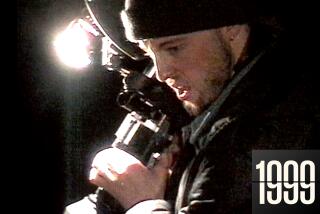The scary ‘Ring’ is a pleasant surprise
No one saw it coming: the box-office clout of “The Ring,” an unheralded remake of a Japanese horror film that could crack the $100-million mark by Monday -- outdistancing higher-profile fare such as “Red Dragon” and becoming a huge word-of-mouth hit.
Not the critics, one of whom predicted that “mass popularity will elude it because it has a no-name cast, cryptic tone and obscure origins.” Not the public, which had little awareness of the movie 10 days before its Oct. 18 opening. Not even DreamWorks Pictures, the studio that released it.
“We’d be liars if we didn’t say we were surprised,” said marketing chief Terry Press. “It would be nice to take credit for being geniuses, but most of the second part of the campaign was born out of panic. When people congratulate us we smile weakly, since, prior to the opening, it was a nail-biting couple of weeks.”
After a series of promotional course corrections, the movie took off, becoming mandatory viewing in some quarters of the teenage population (the film is rated PG-13). Part of the phenomenon can be chalked up to a grass-roots Internet campaign that never mentioned “The Ring” by name but spread the notion of its premise (a videotape that kills) as a Japanese urban legend.
In the film, directed by Gore Verbinski (“The Mexican,” “Mouse Hunt”), a haunted videocassette strikes viewers dead a week after they watch it. A telephone call (“the ring”) with a simple message (“seven days”) informs people of their plight. Seattle newspaper reporter Rachel Keller (Naomi Watts), the aunt of one victim, tries to unravel the mystery with the help of a former lover (Martin Henderson). Because they, and her son, have all seen the footage, it’s an archetypal race against time.
Walter Parkes, co-head of DreamWorks’ motion picture division, bought the project in January 2001, just hours after the studio watched the original on, appropriately, a badly dubbed videotape.
Hideo Nakata’s “Ringu” had been one of the country’s highest-grossing pictures, a cult phenomenon of sorts. An adaptation of the novels of Koji Suzuki (a sort of Stephen King of Japan), it spawned a virtual Ring Cycle -- a sequel, a prequel and a TV show.
The release has been the most “schizophrenic” of his career, Parkes concedes: a rare instance in which the subjective and the objective clashed. He knew that audiences, especially younger ones, responded passionately to the material. But tracking polls reflected little knowledge of the $42-million movie -- or desire to see it. On Oct. 11, 400 sneak previews held in 200-seat theaters were only 60% to 70% full. Had the advertising and Web campaigns missed their mark? Or had research merely failed to pick up teens, the film’s primary audience?
The studio quickly revamped the TV ads, which initially featured a circle -- a central image in the film -- with the line, “Before you die, you see the ring.” Adding audience reaction spots, they figured, would play up the “fun” aspect, and featuring the well into which Keller falls added mystery and specificity. Two weeks before the opening, newspaper ads put a human face on the movie by inserting a shot of Watts screaming.
A decision was made to open in 1,981 theaters, fewer than the 2,500 initially planned. Better to let word of mouth build, the reasoning went, and let the theaters fill up. “The experience of seeing the movie with a large audience far outweighed the benefit of going really wide,” said DreamWorks distribution head Jim Tharp.
The strategy worked. “The Ring” took in $15 million during its first weekend, considerably more than the $10 million to $11 million the studio had expected. With the addition of 600 screens, the box office take was $18.5 million the next weekend. Though most movies drop an average of 35% to 40% on the third weekend, Tharp notes, “The Ring” broke the rules: The film took in $18 million on that go-round, and $15.5 million during weekend No. 4 in 2,900 theaters.
With more than half of its audience younger than 25, “The Ring” has morphed into a big date movie and a communal screamfest for 13- to 16-year-olds. Elated executives knew they had something big on their hands when informed that two teens had come to a Halloween party dressed as Samara, a character in the film.
“You shouldn’t underestimate the importance of the PG-13 rating,” Press says. “Teens can’t believe they get to go to a scary movie unaccompanied by their parents.”
Cutting some gore to get the rating, Parkes says, made for a better picture, one more aligned with the dreamy suspense of David Lynch and M. Night Shyamalan’s “The Sixth Sense” than with the more conventional “Scream.”
Projections call for the movie to take in upwards of $125 million. And because the studio has already approached Verbinski, Watts and screenwriter Ehren Kruger (“Arlington Road”) about a sequel, there’s the distinct possibility of an afterlife.
The ending of “The Ring” plays well into a sequel, said Parkes. But the challenges remain. “Naomi follows the clues on the tape in the original, so we have to broaden the concept,” he explained. “Having the video out in the world is a good setup, of course, but what seems like a gimme is not.”


